Geochronological and Geochemical Constraints on the Petrogenesis of Lamprophyre from the Giant Weishan REE Deposit in China
Abstract
:1. Introduction
2. Geological Setting
3. Petrography
3.1. Kersantite
3.2. Damkjernite
3.3. Spessartite
4. Analytical Methods
4.1. Whole-Rock Major and Trace Element Analyses
4.2. Zircon LA-ICP-MS U-Pb Dating
4.3. Zircon Lu-Hf Isotope
5. Results
5.1. Major and Trace Element Geochemistry
5.2. Zircon U-Pb Geochronology
| Sample | 20CS15 | 21CS03 | 21CS01 | 21CS01A | 11SF01 | 11SF02 | 11SF03 | 11SF04 | 11SF05 | SF1-1 | SF1-2 | 11SZ05-01 | 11SZ05-02 | 11SZ02-01 | 11SZ02-02 | 11SZ02-03 |
|---|---|---|---|---|---|---|---|---|---|---|---|---|---|---|---|---|
| Data Source | This Study | Yang et al. [42] | ||||||||||||||
| SiO2 | 55.44 | 52.74 | 27.08 | 29.93 | 44.08 | 45.56 | 45.55 | 40.22 | 46.23 | 45.99 | 46.04 | 41.51 | 42.38 | 34.74 | 34.42 | 34.39 |
| MgO | 4.55 | 1.79 | 12.16 | 13.07 | 4.73 | 4.18 | 4.73 | 4.4 | 4.92 | 6.11 | 6.03 | 1.71 | 1.74 | 13.92 | 13.78 | 13.76 |
| K2O | 1.80 | 6.33 | 7.39 | 6.56 | 4.2 | 4.2 | 4.22 | 3.82 | 4.34 | 3.79 | 3.98 | 3.62 | 3.64 | 3.08 | 3.13 | 3.13 |
| Na2O | 7.45 | 3.53 | 0.25 | 0.79 | 1.54 | 1.62 | 1.6 | 1.26 | 1.43 | 1.85 | 1.72 | 2.78 | 2.84 | 0.77 | 0.76 | 1.2 |
| CaO | 5.20 | 2.05 | 16.17 | 14.76 | 12.57 | 12.12 | 11.51 | 11.75 | 12.01 | 11.02 | 11.15 | 16.38 | 16.82 | 12.05 | 12.03 | 11.98 |
| Al2O3 | 12.31 | 18.80 | 7.21 | 6.59 | 10.46 | 10.55 | 10.52 | 9.41 | 10.52 | 10.98 | 10.75 | 11.91 | 12.13 | 7.08 | 7 | 6.99 |
| TFe2O3 | 8.32 | 8.56 | 7.32 | 6.60 | 5.83 | 6.03 | 5.89 | 5.19 | 5.8 | 5.87 | 5.81 | 5.26 | 5.37 | 10.97 | 11.03 | 11 |
| TiO2 | 0.59 | 0.52 | 0.80 | 0.72 | 0.75 | 0.78 | 0.74 | 0.61 | 0.65 | 0.76 | 0.72 | 0.5 | 0.51 | 2.25 | 2.25 | 2.25 |
| P2O5 | 0.68 | 0.23 | 2.46 | 2.13 | 0.78 | 0.87 | 0.78 | 0.69 | 0.75 | 0.83 | 0.83 | 0.87 | 0.89 | 1.67 | 1.69 | 1.67 |
| MnO | 0.08 | 0.07 | 0.15 | 0.18 | 0.08 | 0.08 | 0.07 | 0.06 | 0.07 | 0.08 | 0.07 | 0.09 | 0.09 | 0.14 | 0.14 | 0.14 |
| LOI | 4.76 | 3.56 | 12.84 | 11.22 | 13.78 | 12.76 | 13.18 | 22.3 | 12.62 | 12.26 | 12.29 | 14.81 | 13.32 | 13.24 | 13.18 | 13.19 |
| Total (%) | 101.16 | 98.19 | 93.82 | 92.53 | 98.8 | 98.8 | 98.8 | 99.73 | 99.35 | 99.5 | 99.39 | 99.43 | 99.72 | 99.92 | 99.42 | 99.69 |
| K2O + Na2O | 9.25 | 9.86 | 7.64 | 7.35 | 5.74 | 5.82 | 5.82 | 5.09 | 5.77 | 5.64 | 5.7 | 6.4 | 6.47 | 3.85 | 3.89 | 4.33 |
| K2O/Na2O | 0.24 | 1.79 | 30.04 | 8.27 | 0.37 | 0.39 | 0.38 | 0.33 | 0.33 | 0.49 | 0.43 | 0.77 | 0.78 | 0.25 | 0.24 | 0.38 |
| Mg# | 52.24 | 29.49 | 76.87 | 79.83 | 64 | 60 | 64 | 65 | 65 | 70 | 70 | 42 | 42 | 74 | 73 | 73 |
| K/Al | 0.17 | 0.40 | 1.22 | 1.19 | 0.48 | 0.47 | 0.48 | 0.48 | 0.49 | 0.41 | 0.44 | 0.36 | 0.36 | 0.52 | 0.53 | 0.53 |
| K/(Na + K) | 0.14 | 0.54 | 0.95 | 0.85 | 0.64 | 0.63 | 0.63 | 0.67 | 0.67 | 0.57 | 0.60 | 0.46 | 0.46 | 0.73 | 0.73 | 0.63 |
| La | 248.29 | 285.91 | 487.81 | 942.85 | 212 | 216 | 209 | 199 | 198 | 199 | 206 | 279 | 274 | 147 | 160 | 158 |
| Ce | 471.20 | 514.98 | 767.85 | 1255.00 | 401 | 405 | 393 | 392 | 388 | 378 | 406 | 543 | 535 | 321 | 325 | 325 |
| Pr | 51.69 | 49.82 | 79.02 | 111.15 | 43.9 | 44.4 | 42.9 | 44.9 | 43.9 | 41.3 | 46.4 | 62.5 | 60.7 | 37.5 | 39.9 | 40.8 |
| Nd | 163.43 | 156.05 | 271.05 | 334.76 | 162 | 164 | 157 | 165 | 160 | 162 | 170 | 230 | 219 | 145 | 155 | 155 |
| Sm | 21.89 | 16.34 | 39.84 | 36.47 | 22.7 | 22.8 | 21.8 | 22.2 | 21.6 | 22.2 | 23 | 34.9 | 32.8 | 22.5 | 24 | 23.9 |
| Eu | 5.07 | 3.78 | 10.18 | 8.53 | 5.17 | 5.2 | 4.93 | 4.87 | 4.77 | 5.07 | 5.04 | 8.14 | 7.75 | 5.66 | 5.94 | 5.98 |
| Gd | 14.84 | 10.35 | 28.75 | 23.35 | 13.5 | 13.7 | 12.5 | 14.6 | 14.5 | 14.9 | 14.8 | 22.7 | 21.2 | 15.6 | 16.8 | 16.2 |
| Tb | 1.30 | 0.95 | 3.24 | 2.05 | 1.29 | 1.32 | 1.26 | 1.33 | 1.32 | 1.41 | 1.37 | 1.96 | 1.88 | 1.54 | 1.59 | 1.62 |
| Dy | 5.00 | 4.52 | 15.20 | 8.64 | 5.47 | 5.64 | 5.47 | 5.31 | 5.31 | 5.85 | 5.5 | 7.97 | 7.71 | 6.69 | 7.13 | 6.91 |
| Ho | 0.73 | 0.60 | 2.10 | 1.12 | 0.83 | 0.83 | 0.82 | 0.84 | 0.84 | 0.86 | 0.86 | 1.2 | 1.14 | 1.02 | 1.11 | 1.11 |
| Er | 1.63 | 1.90 | 5.80 | 3.12 | 1.74 | 1.78 | 1.71 | 1.77 | 1.78 | 1.95 | 1.8 | 2.45 | 2.36 | 2.14 | 2.34 | 2.37 |
| Tm | 0.17 | 0.17 | 0.69 | 0.36 | 0.22 | 0.22 | 0.22 | 0.22 | 0.22 | 0.22 | 0.22 | 0.31 | 0.29 | 0.27 | 0.29 | 0.29 |
| Yb | 1.06 | 1.13 | 5.00 | 2.88 | 1.32 | 1.31 | 1.3 | 1.29 | 1.33 | 1.29 | 1.32 | 1.82 | 1.69 | 1.46 | 1.63 | 1.62 |
| Lu | 0.12 | 0.10 | 0.59 | 0.37 | 0.17 | 0.18 | 0.18 | 0.18 | 0.18 | 0.17 | 0.19 | 0.24 | 0.24 | 0.2 | 0.21 | 0.21 |
| Zr | 587.35 | 623.90 | 868.60 | 801.45 | 223 | 234 | 231 | 220 | 230 | 230 | 231 | 299 | 297 | 312 | 321 | 334 |
| Nb | 27.15 | 73.06 | 10.61 | 12.06 | 8.2 | 8.36 | 8.27 | 7.68 | 7.8 | 8.2 | 7.99 | 10.9 | 11 | 61.5 | 62.6 | 62.4 |
| Ti | 3519.60 | 3116.54 | 4794.67 | 4285.24 | 4500 | 4680 | 4440 | 3660 | 3900 | 4560 | 4320 | 3000 | 3060 | 13,500 | 13,500 | 13,500 |
| V | 81.49 | 66.15 | 121.14 | 105.94 | 85.5 | 85.2 | 85.6 | 78.9 | 80.7 | 90.7 | 83.3 | 99.1 | 99.3 | 183 | 168 | 185 |
| Cr | 35.30 | 8.62 | 496.46 | 401.29 | 535 | 530 | 531 | 510 | 510 | 532 | 518 | 104 | 108 | 624 | 322 | 629 |
| Co | 13.61 | 4.44 | 39.48 | 41.43 | 23.1 | 26.8 | 27.8 | 21.5 | 26.7 | 21.2 | 21.1 | 19.6 | 19.7 | 58.1 | 55.4 | 56.7 |
| Ni | 24.20 | 9.43 | 282.26 | 377.92 | 269 | 269 | 246 | 234 | 219 | 242 | 243 | 106 | 106 | 325 | 311 | 319 |
| Cu | 24.19 | 31.23 | 16.95 | 62.66 | 12.2 | 13.7 | 15.4 | 13.1 | 15.9 | 14.1 | 15.2 | 46.8 | 47.6 | 60.2 | 57.7 | 59.4 |
| Zn | 54.94 | 53.73 | 149.61 | 165.00 | 81.9 | 85.4 | 78.6 | 84.6 | 81.8 | 76.4 | 88.8 | 77.1 | 79.6 | 106 | 105 | 105 |
| Ga | 29.50 | 52.80 | 84.10 | 131.70 | 19 | 19.4 | 19 | 17.8 | 17.6 | 16.2 | 17.9 | 19.8 | 19.4 | 15.7 | 15.8 | 16.1 |
| Rb | 45.47 | 141.39 | 547.10 | 383.06 | 113 | 105 | 108 | 113 | 107 | 96.7 | 102 | 73.8 | 74.8 | 56.4 | 70.4 | 72.2 |
| Sr | 5967.00 | 1037.34 | 9809.50 | 8965.21 | 738 | 725 | 771 | 694 | 730 | 981 | 991 | 684 | 690 | 1162 | 1182 | 1213 |
| Cs | 2.12 | 0.75 | 9.66 | 6.74 | 6.13 | 5.65 | 5.79 | 6.8 | 6.34 | 4.89 | 5.77 | 1.79 | 1.82 | 63.9 | 67.9 | 70.6 |
| Ba | 2814.60 | 1651.00 | 3597.10 | 6457.00 | 2199 | 2008 | 2032 | 2177 | 2017 | 2188 | 2536 | 740 | 753 | 1705 | 1751 | 1801 |
| Ta | 2.53 | 1.73 | 0.41 | 0.47 | 0.33 | 0.33 | 0.33 | 0.35 | 0.37 | 0.34 | 0.36 | 0.48 | 0.45 | 3.34 | 3.34 | 3.57 |
| Pb | 30.48 | 17.15 | 17.39 | 29.17 | 10.4 | 11.2 | 11.6 | 10.7 | 12 | 10.1 | 11 | 29.8 | 28.2 | 15 | 15.3 | 15.4 |
| U | 8.01 | 1.68 | 1.81 | 1.72 | 1.67 | 1.73 | 1.63 | 1.68 | 4.87 | 4.65 | 11.05 | 10.8 | 11.2 | |||
| Th | 23.98 | 49.72 | 6.50 | 9.81 | 20 | 20.7 | 20.4 | 19.5 | 19.7 | 20.1 | 20.2 | 36.2 | 34.9 | 6.75 | 18.2 | 18.1 |
| Y | 20.18 | 20.92 | 89.29 | 50.29 | 24.3 | 24.6 | 23.7 | 23.1 | 22.8 | 24.3 | 23.7 | 31.5 | 32.2 | 20.8 | 25.4 | 26.2 |
| Sc | 5.63 | 2.50 | 13.70 | 12.68 | 13.2 | 13.3 | 13.4 | 13.2 | 13.3 | 13.3 | 12.9 | 9.48 | 9.53 | 3.81 | 19.7 | 20 |
| REE | 1012.23 | 1070.03 | 1820.09 | 2793.61 | 871 | 883 | 851 | 853 | 841 | 834 | 882 | 1196 | 1165 | 707 | 740 | 740 |
| LREEs | 976.40 | 1037.23 | 1684.48 | 2712.10 | 847 | 858 | 828 | 827 | 815 | 807 | 856 | 1157 | 1129 | 678 | 709 | 709 |
| HREEs | 35.83 | 32.80 | 135.61 | 81.50 | 24.6 | 25 | 23.5 | 25.5 | 25.4 | 26.7 | 26.1 | 38.6 | 36.5 | 28.9 | 31.1 | 30.3 |
| LREEs/HREEs | 27.25 | 31.62 | 12.42 | 33.28 | 34.5 | 34.3 | 35.3 | 32.4 | 32.1 | 30.2 | 32.8 | 30 | 30.9 | 23.4 | 22.8 | 23.4 |
| δCe | 0.95 | 0.96 | 0.86 | 0.79 | 1.00 | 0.99 | 1.00 | 1.00 | 1.00 | 1.01 | 1.00 | 0.98 | 1.00 | 1.08 | 0.96 | 0.95 |
| δEu | 0.81 | 0.83 | 0.88 | 0.84 | 0.83 | 0.83 | 0.84 | 0.78 | 0.78 | 0.8 | 0.78 | 0.83 | 0.84 | 0.88 | 0.86 | 0.88 |
| Lu/Yb | 0.11 | 0.09 | 0.12 | 0.13 | 0.13 | 0.14 | 0.14 | 0.14 | 0.14 | 0.13 | 0.14 | 0.13 | 0.14 | 0.14 | 0.13 | 0.13 |
| Nb/Yb | 25.62 | 64.94 | 2.12 | 4.18 | 6.21 | 6.38 | 6.36 | 5.95 | 5.86 | 6.36 | 6.05 | 5.99 | 6.51 | 42.12 | 38.40 | 38.52 |
| Th/Yb | 18.48 | 52.08 | 2.01 | 4.79 | 15.15 | 15.80 | 15.69 | 15.12 | 14.81 | 15.58 | 15.30 | 19.89 | 20.65 | 4.62 | 11.17 | 11.17 |
| La/Sm | 11.34 | 17.50 | 12.24 | 25.85 | 9.34 | 9.47 | 9.59 | 8.96 | 9.17 | 8.96 | 8.96 | 7.99 | 8.35 | 6.53 | 6.67 | 6.61 |
| Rb/Sr | 0.01 | 0.14 | 0.06 | 0.04 | 0.15 | 0.14 | 0.14 | 0.16 | 0.15 | 0.1 | 0.1 | 0.11 | 0.11 | 0.05 | 0.06 | 0.06 |
| Ba/Rb | 61.90 | 11.68 | 6.57 | 16.86 | 19.5 | 19.2 | 18.9 | 19.3 | 18.9 | 22.6 | 24.8 | 10 | 10.1 | 30.2 | 24.9 | 25 |
| Dy/Yb | 4.72 | 4.02 | 3.04 | 3.00 | 26.40 | 26.60 | 26.94 | 24.57 | 27.08 | 24.38 | 25.02 | 16.50 | 17.87 | 17.51 | 15.93 | 16.03 |
| K/(Yb*1000) | 14.12 | 46.69 | 12.27 | 18.86 | 4.14 | 4.31 | 4.21 | 4.12 | 3.99 | 4.53 | 4.17 | 4.38 | 4.56 | 4.58 | 4.37 | 4.27 |
| Nb/U | 3.38 | 4.88 | 4.62 | 4.8 | 4.61 | 4.52 | 5.02 | 4.76 | 2.23 | 2.37 | 5.56 | 5.8 | 5.58 | |||
| Ba/Th | 117.36 | 33.20 | 553.33 | 658.29 | 109.95 | 97.00 | 99.61 | 111.64 | 102.39 | 108.86 | 125.54 | 20.44 | 21.58 | 252.59 | 96.21 | 99.50 |
| Th/Nb | 0.88 | 0.68 | 0.61 | 0.81 | 2.44 | 2.48 | 2.47 | 2.54 | 2.53 | 2.45 | 2.53 | 3.32 | 3.17 | 0.11 | 0.29 | 0.29 |
| La/Ta | 97.96 | 165.39 | 1201.02 | 1995.94 | 642.42 | 654.55 | 633.33 | 568.57 | 535.14 | 585.29 | 572.22 | 581.25 | 608.89 | 44.01 | 47.90 | 44.26 |
| Sr/Th | 248.80 | 20.86 | 1508.96 | 914.01 | 36.90 | 35.02 | 37.79 | 35.59 | 37.06 | 48.81 | 49.06 | 18.90 | 19.77 | 172.15 | 64.95 | 67.02 |
| Th/Ce | 0.05 | 0.10 | 0.01 | 0.01 | 0.05 | 0.05 | 0.05 | 0.05 | 0.05 | 0.05 | 0.05 | 0.07 | 0.07 | 0.02 | 0.06 | 0.06 |
| (La/Sm)N | 7.13 | 11.01 | 7.70 | 16.26 | 6.04 | 6.12 | 6.20 | 5.79 | 5.92 | 5.79 | 5.79 | 5.17 | 5.40 | 4.22 | 4.31 | 4.27 |
| (Gd/Yb)N | 11.30 | 7.42 | 4.64 | 6.53 | 8.46 | 8.65 | 7.95 | 9.36 | 9.02 | 9.55 | 9.27 | 10.32 | 10.38 | 8.84 | 8.53 | 8.27 |
| (La/Yb)N | 157.95 | 171.33 | 65.79 | 220.46 | 115.25 | 118.32 | 115.37 | 110.70 | 106.83 | 110.70 | 111.99 | 110.01 | 116.35 | 72.25 | 70.44 | 69.99 |
| (La/Lu)N | 218.36 | 286.38 | 85.37 | 261.66 | 134.33 | 129.26 | 125.07 | 119.08 | 118.49 | 126.09 | 116.79 | 125.22 | 122.97 | 79.17 | 82.07 | 81.04 |
5.3. Zircon Lu-Hf Isotope
6. Discussion
6.1. Early Cretaceous Intrusion of Lamprophyre Dike
6.2. Crustal Contamination
6.3. Nature of the Magma Source
6.4. Modification of the Mantle Source by Metasomatism
7. Conclusions
Author Contributions
Funding
Acknowledgments
Conflicts of Interest
References
- Rock, N.M.S. The nature and origin of the lamprophyres: An overview. Geol. Soc. Lond. Spec. Publ. 1987, 30, 191–226. [Google Scholar] [CrossRef]
- Currie, K.L.; Williams, P.R. An Archean calc-alkaline lamprophyre suite, northeastern Yilgarn Block, western Australia. Lithos 1993, 31, 33–50. [Google Scholar] [CrossRef]
- Ivanov, A.V.; Levitskii, V.I.; Corfu, F.; Demonterova, E.I.; Reznitski, L.Z. Shoshonitic magmatism in the paleoproterozoic of the south-western Siberian craton: An analogue of the modern post-collision setting. Lithos 2019, 328, 88–100. [Google Scholar] [CrossRef]
- Pandey, A.; Rao, N.V.C.; Chakrabarti, R.; Pandit, D.; Pankaij, P.; Kumar, A.; Sahoo, S. Petrogenesis of Mesoproterozoic shoshonitic lamprophyre dyke from the Wajrakarur kimberlite field, eastern Dharwar craton, southern India: Geochemical and Sr-Nd isotopic evidence for a modified sub-continental lithospheric mantle source. Lithos 2017, 292, 218–233. [Google Scholar] [CrossRef]
- Soder, C.; Altherr, R.; Romer, R.L. Mantle metasomatism at the edge of a retreating subduction zone: Late Neogene lamprophyres from the Island of Kos, Greece. J. Petrol. 2016, 57, 1705–1728. [Google Scholar] [CrossRef] [Green Version]
- Choi, E.; Fiorentini, M.L.; Giuliani, A.; Foley, S.F.; Maas, R.; Taylor, W.R. Subductionrelated petrogenesis of Late Archean calc-alkaline lamprophyres in the Yilgarn Craton (Western Australia). Precambrian Res. 2019, 338, 105550. [Google Scholar] [CrossRef]
- Jia, L.Q.; Mo, X.X.; Dong, G.C.; Xu, W.Y.; Wang, L.; Guo, X.D.; Wang, Z.H.; Wei, S.G. Genesis of lamprophyres from Machangqing, western Yunnan: Constraints from geochemistry, geochronology and Sr-Nd-Pb-Hf isotopes. Acta Petrol. Sin. 2013, 29, 1247–1260. [Google Scholar]
- Qiu, K.-F.; Yu, H.-C.; Hetherington, C.; Huang, Y.-Q.; Yang, T.; Deng, J. Tourmaline composition and boron isotope signature as a tracer of magmatic-hydrothermal processes. Am. Mineral. 2021, 106, 1033–1044. [Google Scholar] [CrossRef]
- Yu, H.C.; Qiu, K.F.; Hetherington, C.J.; Chew, D.; Huang, Y.Q.; He, D.Y.; Geng, J.Z.; Xian, H.Y. Apatite as an alternative petrochronometer to trace the evolution of magmatic systems containing metamict zircon. Contrib. Mineral. Petrol. 2021, 176, 68. [Google Scholar] [CrossRef]
- Xie, Y.L.; Xia, J.M.; Cui, K.; Qu, Y.W.; Liang, P.; Zhong, R.C. Rare earth elements deposits in China Spatio-temporal distiboution and ore foming processes (in Chinese). Chin. Sci. Bull. 2020, 65, 3794–3808. [Google Scholar] [CrossRef]
- Wu, M.Q.; Samon, I.M.; Qiu, K.F.; Zhang, D.H. Multi-stage metasomatic Zr mineralization in the world-class Baerzhe Rare earth element-Nb-Zr-Be deposit. Am. Mineral. 2022, in press. [Google Scholar] [CrossRef]
- Wu, M.Q.; Samson, I.M.; Qiu, K.F.; Zhang, D.H. Concentration mechanisms of REE-Nb-Zr-Be mineralization in the Baerzhe deposit, NE China: Insights from textural and chemical features of amphibole and rare-metal minerals. Econ. Geol. 2021, 116, 651–679. [Google Scholar] [CrossRef]
- Tian, J.X.; Zhang, R.T.; Fan, Y.C.; Li, X.Z.; Xu, H.Y.; Wang, B.Y. Geological Characteristics and Relation with Rare Earth Elements of Alkalic Complex in Chishan of Shandong Province. Shandong Geol. 2002, 18, 21–25. [Google Scholar]
- Li, J.K.; Yuan, Z.X.; Bai, G.; Chen, Y.C.; Wang, D.H.; Ying, L.J.; Zhang, J. Ore-forming Fluid Eovlvement and its Controlling to REE (AG) Mineralizing in the Weuishan Deposit, Shandong. Mineral. Petrol. 2009, 29, 60–68. [Google Scholar]
- Yu, X.F.; Tang, H.S.; Han, Z.Z.; Li, C.Y. Geological Characteristics and Origin of Rare Earth Elements Deposits Related with Alkaline Rock in the Chishan-Longbaoshan Area, Shandong Province. Acta Geol. Sin. 2010, 84, 407–417. [Google Scholar]
- Lan, T.G.; Fan, H.R.; Hu, F.F.; Yang, K.F.; Wang, Y. Genesis of the Weishan REE deposit, Shandong Province:Evidences from Rb-Sr isochron age, LA-MC-ICPMS Nd isotopic compositions and fluid inclusions. Geochimica 2011, 40, 428–442. [Google Scholar]
- Zhang, P.; Lan, J. Metallogenic Model and Genesis of Rare Earth Deposits in Western Shandong. Shandong Land Res. 2020, 36, 15–19. [Google Scholar]
- Wang, Y.; Qiu, K.F.; Müller, A.; Hou, Z.L.; Zhu, Z.H.; Yu, H.C. Machine learning prediction of quartz forming-environments. J. Geophys. Res. Solid Earth 2021, 126, e2021JB021925. [Google Scholar] [CrossRef]
- Lan, J. Study on Metallogenic Regularities of Rare Earth Deposit in Xishan Area of Weishan County in Shandong Province. Shandong Land Res. 2019, 35, 39–43. [Google Scholar]
- Long, Z.Y.; Qiu, K.F.; Santosh, M.; Yu, H.C.; Jiang, X.Y.; Zou, L.Q.; Tang, D.W. Fingerprinting the metal source and cycling of the world’s largest antimony deposit in Xikuangshan, China. Geol. Soc. Am. Bull. 2022. [Google Scholar] [CrossRef]
- Liang, Y.W.; Lai, Y.; Hu, H.; Zhang, F. Zircon U-Pb Ages and Geochemical Characteristics Study of Syenite from Weishan REE Deposit, Western Shandong. J. Peking Univ. 2017, 53, 652–666. [Google Scholar]
- Li, S.J.; Hong, M.; Xu, Y.M.; Rui, Z.F.; Wang, J.X. An Opinion on Employment of the Jurassic and Cretaceous Lithostratigraphic Units in the West Shandong Area. Geol. Rev. 2007, 53, 6–10. [Google Scholar]
- Wang, J.F.; Sun, M.T.; Du, X.B.; Gan, Y.J.; Zhang, G.Q.; Wang, Z.L. Geological Characteristics and Prospecting Potentiality of Xishan Rare Earth Deposit in Shandong Province. Shandong Land Res. 2016, 32, 32–40. [Google Scholar]
- Hu, Q.Y.; Li, L.; Tang, Z.B.; Shi, X.P. Characteristics and mechanism of Late Mesozoic extensional faults in West Shandong Uplift. Geol. China 2009, 36, 1233–1244. [Google Scholar]
- Wei, P.F.; Yu, X.F.; Li, D.P.; Liu, Q.; Yu, L.D.; Li, Z.S.; Geng, K.; Zhang, Y.; Sun, Y.Q.; Chi, N.J. Geochemistry, Zircon U-Pb Geochronology, and Lu-Hf Isotopes of the Weishan Alkaline Complex, Western Shandong, China. Minerals 2019, 9, 293. [Google Scholar] [CrossRef] [Green Version]
- Qiu, K.F.; Yu, H.C.; Deng, J.; Mclntire, D.; Gou, Z.Y.; Geng, J.Z.; Chang, Z.S.; Zhu, R.; Li, K.N.; Goldfarb, R. The giant Zaozigou Au-Sb deposit in West Qinling, China: Magmatic- or metamorphic-hydrothermal origin? Miner. Depos. 2020, 18, 345–362. [Google Scholar] [CrossRef]
- Qiu, K.F.; Goldfarb, R.J.; Deng, J.; Yu, H.C.; Gou, Z.Y.; Ding, C.J.; Wang, Z.K.; Li, D.P. Gold deposits of the Jiaodong Peninsula, eastern China. Soc. Econ. Geol. Spec. Publ. 2020, 23, 753–773. [Google Scholar]
- Qiu, K.F.; Yu, H.C.; Wu, M.Q.; Geng, J.Z.; Ge, X.K.; Gou, Z.Y.; Taylor, R.D. Discrete Zr and REE mineralization of the Baerzhe rare-metal deposit, China. Am. Mineral. 2019, 104, 1487–1502. [Google Scholar] [CrossRef]
- Huang, Y.Q.; Wu, M.Q.; Germain, B.; Yu, H.C.; Qiao, B.X.; Zhao, Z.G.; Qiu, K.F. Geodynamic setting and ore formation of the Younusisayi thorium deposit in the Altyn orogenic belt, NW China. Ore Geol. Rev. 2021, 140, 104552. [Google Scholar] [CrossRef]
- Zhao, G.C.; Wilde, S.A.; Cawood, P.A.; Sun, M. Archeanblocks and theirboundariesin the North China Craton: Lithological, geochemical, structuraland p-T path consfaintsandtectonic evolution. Precamb. Res. 2001, 107, 45–73. [Google Scholar] [CrossRef]
- Yang, Y.H.; Wu, F.Y.; Li, Q.L.; Rohas-Agramonte, Y.; Yang, J.H.; Li, Y.; Xu, C. In situ U-Th-Pb dating and Sr-Nd isotope analysis of Bastnäsite by LA-(MC)-ICP-MS. Geostand. Geoanal. Res. 2019, 43, 543–565. [Google Scholar] [CrossRef]
- Liu, Y.S.; Gao, S.; Hu, Z.C.; Gao, C.G.; Zong, K.Q.; Wang, D.B. Continental and oceanic crust recycling-induced melt-peridotite interactions in the Trans-North China Orogen: U-Pb dating, Hf isotopes and trace elements in zircons from mantle xenoliths. J. Petrol. 2010, 51, 537–571. [Google Scholar] [CrossRef]
- Ludwig, K.R. Isoplot v. 3.0: A Geochronological Toolkit for Microsoft Excel; Berkeley Geochronology Center Special Publication: Berkeley, CA, USA, 2003. [Google Scholar]
- Anderson, T. Correction of common lead in U-Pb analyses that do not report 204Pb. Chem. Geol. 2002, 192, 59–79. [Google Scholar] [CrossRef]
- Middlemost, E.A.K. Naming materials in the magma/igneous rock system. EarthSci. Rev. 1996, 37, 215–224. [Google Scholar] [CrossRef]
- Lu, F.X.; Shu, X.X.; Zhao, C.H. Suggestions on classification of lamprophyre. Geol. Sci. Technol. Inf. 1991, 10, 55–62. [Google Scholar]
- Boynton, W.V. Geochemistry of the rare earth elements: Meteorite studies. In Rare Earth Element Geochemistry; Henderson, P., Ed.; Elsevier: New York, NY, USA, 1984; pp. 63–114. [Google Scholar]
- McDonough, W.F.; Sun, S.S. The composition of the Earth. Chem. Geol. 1995, 120, 223–253. [Google Scholar] [CrossRef]
- Sun, S.S.; McDonough, W.F. Chemical and isotopic systematics of oceanic basalts: Implications for mantle composition and processes. Geol. Soc. Lond. Spec. Publ. 1989, 42, 313–345. [Google Scholar] [CrossRef]
- Hoskin, P.W.O.; Schaltegger, U. The composition of zircon and igneous and metamorphic petrogenesis. Rev. Mineral. Geochem. 2003, 53, 27–62. [Google Scholar] [CrossRef]
- Griffin, W.L.; Belousova, E.A.; Shee, S.R.; Pearson, N.J.; O’Reilly, S.Y. Archean crustal evolution in the northern Yilgarn Craton: U-Pb and Hf-isotope evidence from detrital zircons. Precambrian Res. 2004, 131, 231–282. [Google Scholar] [CrossRef]
- Yang, H.T.; Yang, D.B.; Mu, M.S.; Wang, A.Q.; Quan, Y.K.; Hao, L.R.; Xu, W.L.; Yang, D.H. Sr-Nd-Hf isotopic compositions of lamprophyres in western Shandong, China: Implications for the nature of the early cretaceous lithospheric mantle beneath the eastern North China Craton. Lithos 2019, 336, 1–13. [Google Scholar] [CrossRef]
- Qiu, J.S.; Xu, X.S.; Luo, Q.H. Potash-rich volcanic rocks and lamprophyres in the western Shandong Province: 40Ar-39Ar dating and source tracing. Chin. Sci. Bull. 2002, 47, 91–99. [Google Scholar]
- Rapp, R.P.; Watson, E.B. Dehydration Melting of Metabasalt at 8–32 kbar: Implications for Continental Growth and Crust-Mantle Recycling. J. Petrol. 1995, 36, 891–931. [Google Scholar] [CrossRef]
- Wang, X.; Wang, Z.C.; Cheng, H.; Foley, S.; Xiong, L.; Hu, Z.C. Early cretaceous lamprophyre dyke swarms in Jiaodong Peninsula, eastern North China Craton, and implications for mantle metasomatism related to subduction. Lithos 2020, 368–369, 105593. [Google Scholar] [CrossRef]
- Xue, F.; Santosh, M.; Tsunogae, T.; Yang, F. Geochemical and isotopic imprints of early cretaceous mafic and felsic dyke suites track lithosphere-asthenosphere interaction and craton destruction in the North China Craton. Lithos 2019, 326, 174–199. [Google Scholar] [CrossRef]
- Ma, C.Q.; Li, Z.C.; Ehlers, C.; Wang, R.J. A post-collisional magmatic plumbing system: Mesozoic granitoid plutons from the Dabieshan high-pressure and ultrahigh-pressure metamorphic zone, east-central China. Lithos 1998, 45, 431–456. [Google Scholar] [CrossRef]
- Fan, W.; Guo, F.; Wang, Y.; Zhang, H. Late Mesozoic mafic magmatism from the North China Block: Constraints on chemical and isotopic heterogeneity of the subcontinental lithospheric mantle. Geol. Soc. Lond. Spec. Publ. 2007, 280, 77–100. [Google Scholar] [CrossRef]
- Jiang, Y.; Jiang, S.; Ling, H.; Ni, P. Petrogenesis and tectonic implications of Late Jurassic shoshonitic lamprophyre dikes from the Liaodong Peninsula, NE China. Mineral. Petrol. 2010, 100, 127–151. [Google Scholar] [CrossRef]
- Rudnick, R.L.; Fountain, D.M. Nature and composition of the continental crust: A lower crustal perspective. Rev. Geophys. 1995, 33, 267–309. [Google Scholar] [CrossRef] [Green Version]
- Ma, L.; Jiang, S.Y.; Hou, M.L.; Dai, B.Z.; Jiang, Y.H.; Yang, T.; Zhao, K.D.; Pu, W.; Zhu, Z.Y.; Xu, B. Geochemistry of Early Cretaceous calc-alkaline lamprophyres in the Jiaodong Peninsula: Implication for lithospheric evolution of the eastern North China Craton. Gondwana Res. 2014, 25, 859–872. [Google Scholar] [CrossRef]
- Yang, J.H.; Chung, S.L.; Zhai, M.G.; Zhou, X.H. Geochemical and Sr-Nd-Pb isotopic compositions of mafic dikes from the Jiaodong Peninsula, China: Evidence for vein-plus-peridotite melting in the lithospheric mantle. Lithos 2004, 73, 145–160. [Google Scholar] [CrossRef]
- Wan, L.; Zeng, Z.; Kusky, T.; Asimow, P.H.; He, C.; Liu, Y.E.; Yang, S.I.; Xu, S. Geochemistry of middle-late Mesozoic mafic intrusions in the eastern North China Craton: New insights on lithospheric thinning and decratonization. Gondwana Res. 2019, 73, 153–174. [Google Scholar] [CrossRef]
- Liu, S.; Hu, R.Z.; Gao, S.; Feng, C.X.; Yu, B.B.; Feng, G.Y.; Qi, Y.Q.; Wang, T.; Coulson, I.M. Petrogenesis of Late Mesozoic mafic dykes in the Jiaodong Peninsula, eastern North China Craton and implications for the foundering of lower crust. Lithos 2009, 113, 621–639. [Google Scholar] [CrossRef]
- Guo, F.; Fan, W.M.; Wang, Y.J.; Zhang, M. Origin of early Cretaceous calc-alkaline lamprophyres from the Sulu orogen in eastern China: Implications for enrichment processes beneath continental collisional belt. Lithos 2004, 78, 291–305. [Google Scholar] [CrossRef]
- Wu, F.Y.; Li, X.H.; Zheng, Y.F.; Gao, S. Petrogenesis and Petrogenesis of lu-Hf isotopes and their applications. Acta Petrol. Sin. 2007, 23, 185–220. [Google Scholar]
- Zhang, F.; Wang, Y.; Cawood, P.A.; Dong, Y. Geochemistry, 40Ar/39Ar geochronology, and geodynamic implications of Early Cretaceous basalts from the western Qinling orogenic belt, China. J. Asian Earth Sci. 2018, 151, 62–72. [Google Scholar] [CrossRef] [Green Version]
- Wilson, M. Igneous Petrolgenesis: A Global Tectonic Approach; Unwin Hyman: London, UK, 1989; p. 466. [Google Scholar]
- Turner, S.; Caulfield, J.; Turner, M.; Van Keken, P.; Maury, R.; Sandiford, M.; Prouteau, G. Recent contribution of sediments and fluids to the mantle’s volatile budget. Nat. Geosci. 2012, 5, 50–54. [Google Scholar] [CrossRef]
- Foley, S.F.; Jackson, S.E.; Fryer, B.J.; Greenough, J.D.; Jenner, G.A. Trace element partition coefficients for clinopyroxene and phlogopite in an alkaline lamprophyre from Newfoundland by LAM-ICP-MS. Geochim. Cosmochim. Acta 1996, 60, 629–638. [Google Scholar] [CrossRef]
- Ionov, D.A.; Griffin, W.L.; Oreilly, S.Y. Volatile-bearing minerals and lithophile trace elements in the upper mantle. Chem. Geol. 1997, 141, 153–184. [Google Scholar] [CrossRef]
- Latourrette, T.; Hervig, R.L.; Holloway, J.R. Trace element partitioning between amphibole, phlogopite, and basanite melt. Earth Planet. Sci. Lett. 1995, 135, 13–30. [Google Scholar] [CrossRef]
- Furman, T.; Graham, D. Erosion of lithospheric mantle beneath the East African Rift system: Geochemical evidence from the Kivu volcanic province. Dev. Geotecton. 1999, 24, 237–262. [Google Scholar]
- Duggen, S.; Hoernle, K.; Bogaard, P.; Garbe-Schonberg, D. Post-collisional transition from subduction- to intraplate-type magmatism in the westernmost Mediterranean: Evidence for continental-edge delamination of subcontinental lithosphere. J. Petrol. 2005, 46, 1155–1201. [Google Scholar] [CrossRef] [Green Version]
- Robinson, J.A.C.; Wood, B.J. The depth of the spinel to garnet transition at the peridotite solidus. Earth Planet. Sci. Lett. 1998, 164, 277–284. [Google Scholar] [CrossRef]
- Pearce, J.A.; Stern, R.J.; Bloomer, S.H.; Fryer, P. Geochemical mapping of the Mariana arc-basin system: Implications for the nature and distribution of subduction components. Geochem. Geophys. Geosyst. 2005, 6. [Google Scholar] [CrossRef]
- Thompson, R.N.; Morrison, M.A. Asthenospheric and lower-lithospheric mantle contributions to continental extensional magmatism: An example from the British Tertiary Province. Chem. Geol. 1988, 68, 1–15. [Google Scholar] [CrossRef]
- Hofmann, A.W. Chemical differentiation of the Earth: The relationship between mantle, continental crust, and oceanic crust. Earth Planet. Sci. Lett. 1988, 90, 297–314. [Google Scholar] [CrossRef] [Green Version]
- Rudnick, R.L.; Gao, S.; Holland, H.D.; Turekian, K.K. Composition of the continental crust. Treatise Geochem. 2003, 4, 1–51. [Google Scholar]
- Ayers, J. Trace element modeling of aqueous fluid-peridotite interaction in the mantle wedge of subduction zones. Contrib. Mineral. Petrol. 1998, 132, 390–404. [Google Scholar] [CrossRef]
- Devine, J.D. Petrogenesis of the basalt-andesite-dacite association of Grenada, Lesser Antillesisland arc, revisite. J. Volcanol. Geotherm. Res. 1995, 69, 1–33. [Google Scholar] [CrossRef]
- Liang, Y.; Deng, J.; Liu, X.F.; Wang, Q.F.; Ma, Y.; Gao, T.X.; Zhao, L.H. Water Contents of early cretaceous Mafic Dikes in the Jiaodong Peninsula, Eastern North China Craton: Insights into an Enriched Lithospheric Mantle Source Metasomatized by Paleo-Pacific Plate Subduction–Related Fluids. J. Geol. 2019, 127, 343–362. [Google Scholar] [CrossRef]
- Wu, F.Y.; Yang, J.H.; Xu, Y.G.; Wilde, S.A.; Walker, R.J. Destruction of the North China Craton in the Mesozoic. Annu. Rev. Earth Planet. Sci. 2019, 47, 173–195. [Google Scholar] [CrossRef]
- Jenner, F.E.; O’Neill, H.S.C. Analysis of 60 elements in 616 ocean floor basaltic glasses. Geochem. Geophys. Geosyst. 2012, 13, Q02005. [Google Scholar] [CrossRef] [Green Version]
- Li, L.; Zhong, D.L.; Chen, X.F.; Chen, Y. Characteristics of NW-Trending Faults and Evidence of Fission Track in the Luxi Block. Acta Geol. Sin. 2018, 92, 413–436. [Google Scholar]
- Goldfarb, R.J.; Mao, J.W.; Qiu, K.F.; Goryachev, N. The great Yanshanian metallogenic event of eastern Asia: Consequences from one hundred million years of plate margin geodynamics. Gondwana Res. 2021, 100, 223–250. [Google Scholar] [CrossRef]
- Li, S.R.; Santosh, M. Metallogeny and craton destruction: Records from the North China Craton. Ore Geol. Rev. 2014, 56, 376–414. [Google Scholar] [CrossRef]
- Huan, W.L.; Shi, Z.L.; Yan, J.Q. Meso-Cenozoic tectonic evolution of eastern China and adjacent area and movement of the pacific plate. Sci. Geol. Sin. 1982, 17, 179–190. [Google Scholar]
- Zhu, R.X.; Yang, J.H.; Wu, F.Y. Timing of destruction of the North China Craton. Lithos 2012, 149, 51–60. [Google Scholar] [CrossRef]
- Zhu, R.; Zhang, H.; Zhu, G.; Meng, Q.; Fan, H.; Yang, J.-H.; Wu, F.; Zhang, Z.; Zheng, T. Craton destruction and related resources. Int. J. Earth Sci. 2017, 106, 2233–2257. [Google Scholar] [CrossRef]
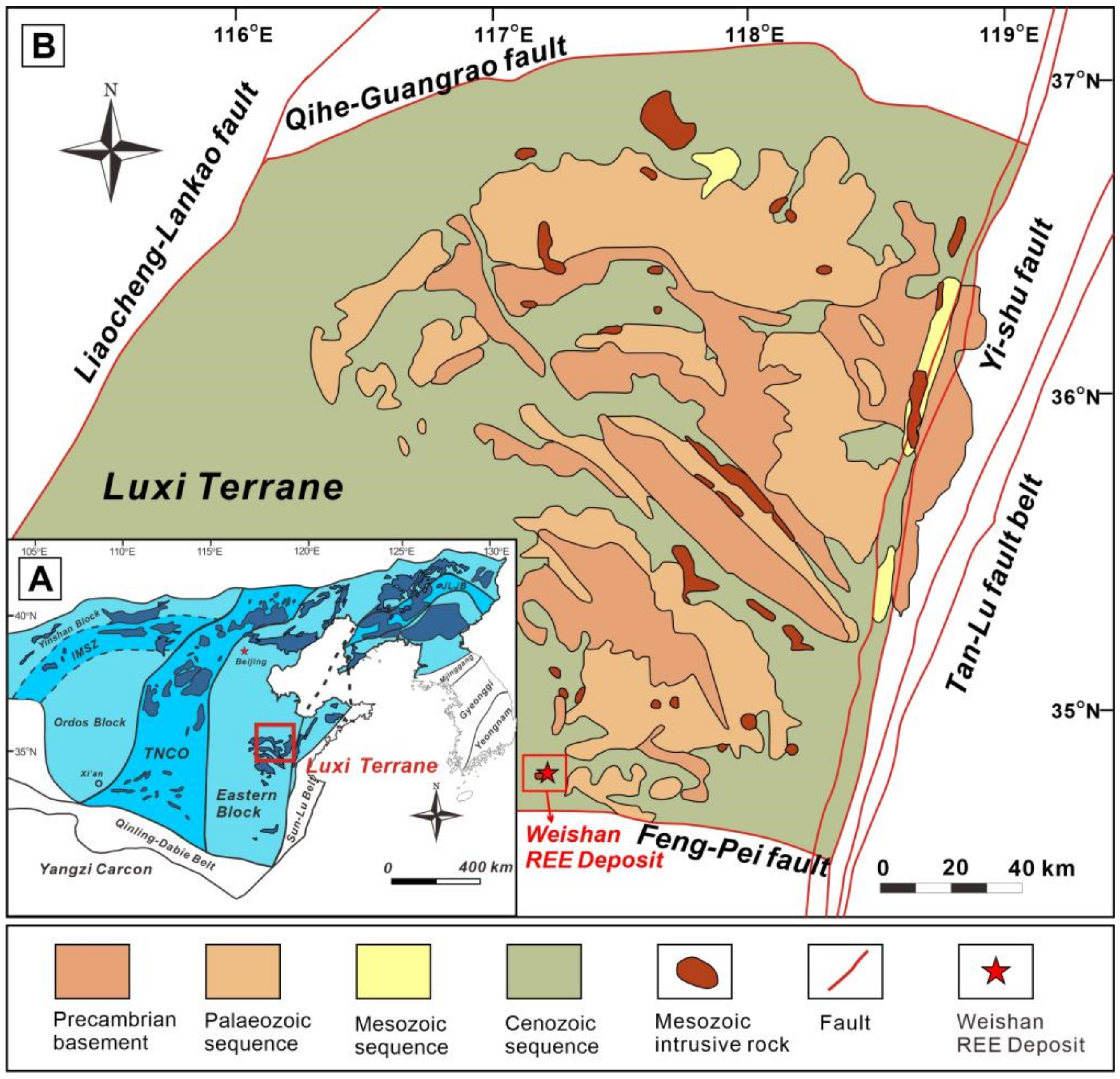
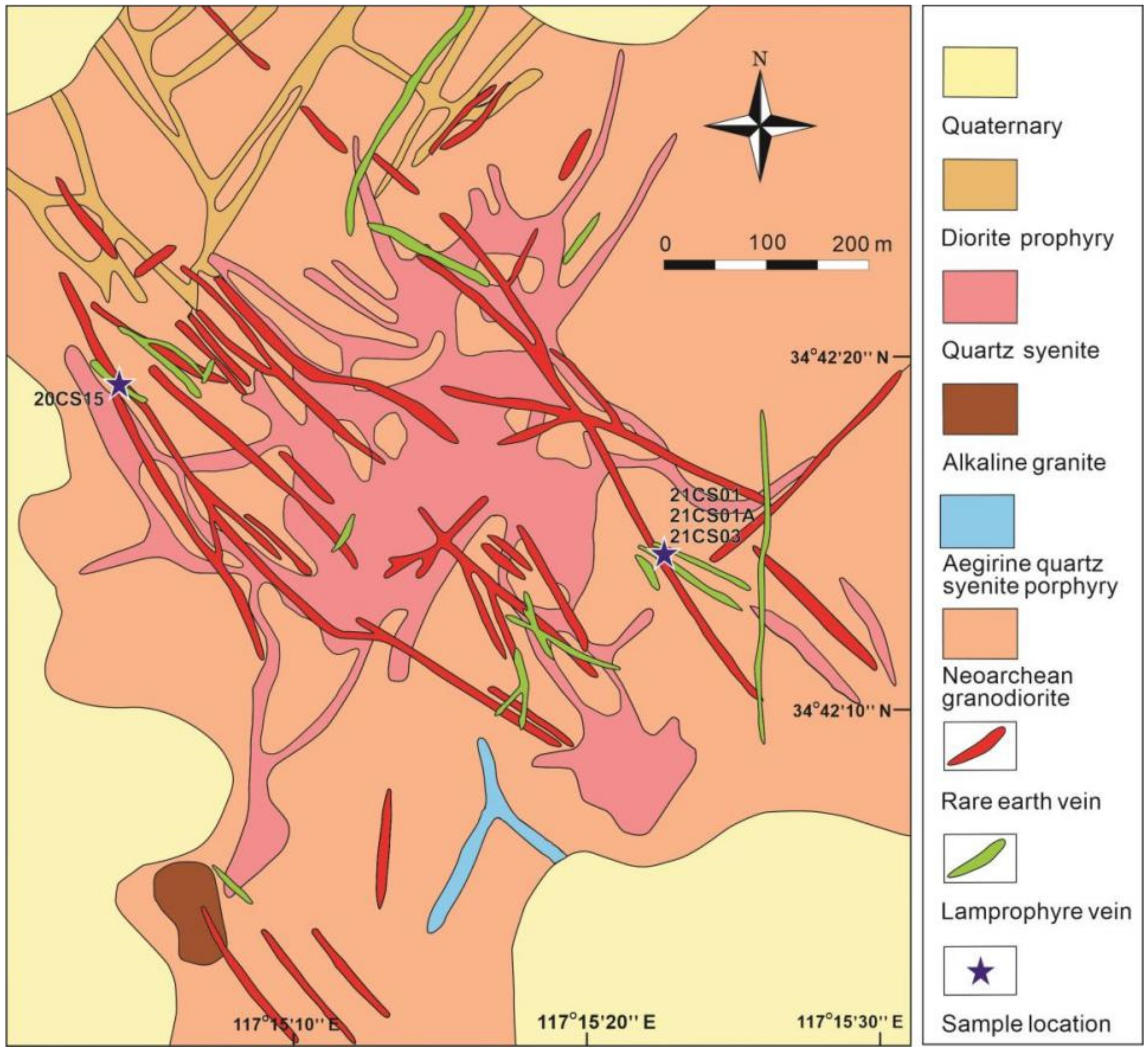
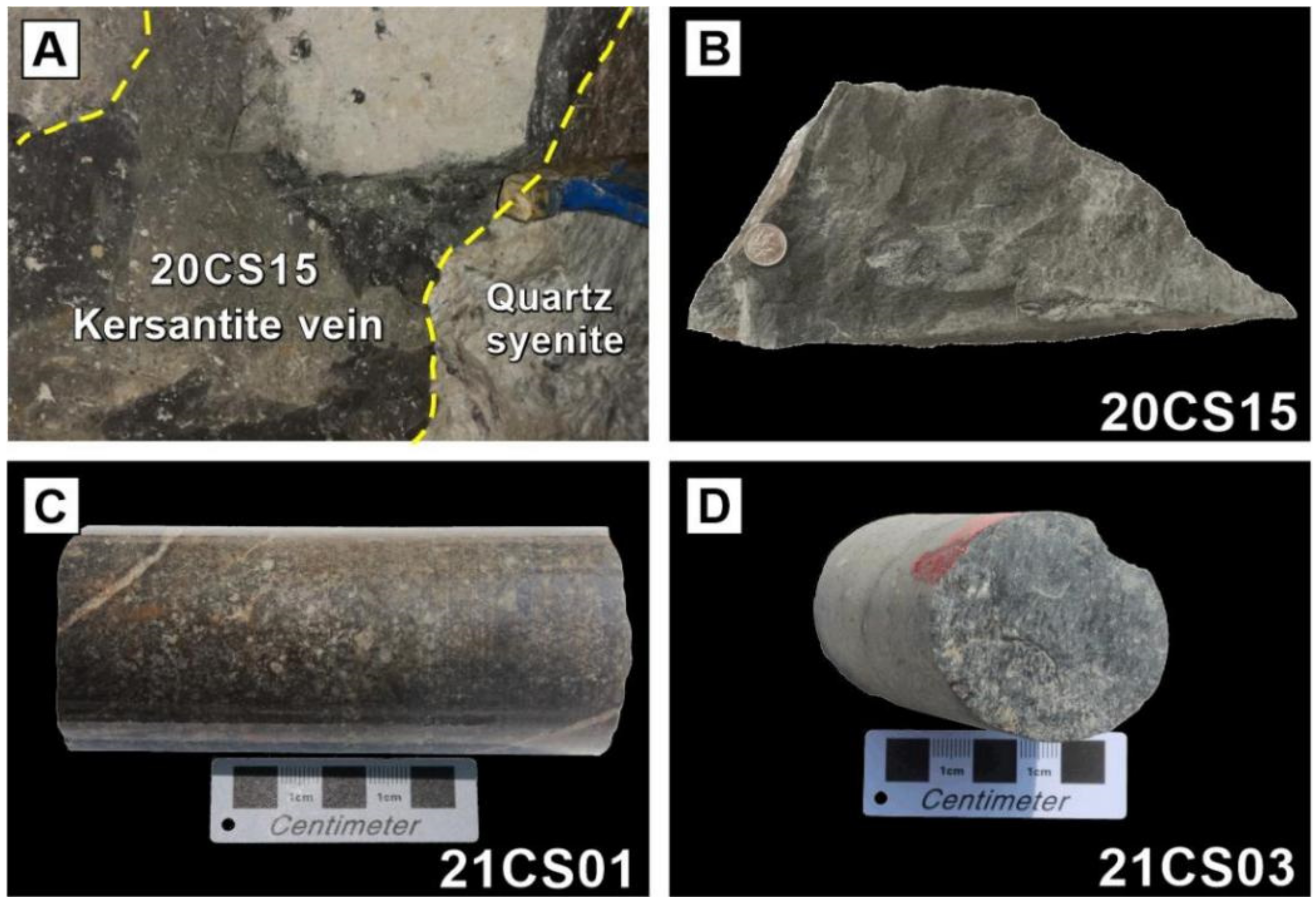
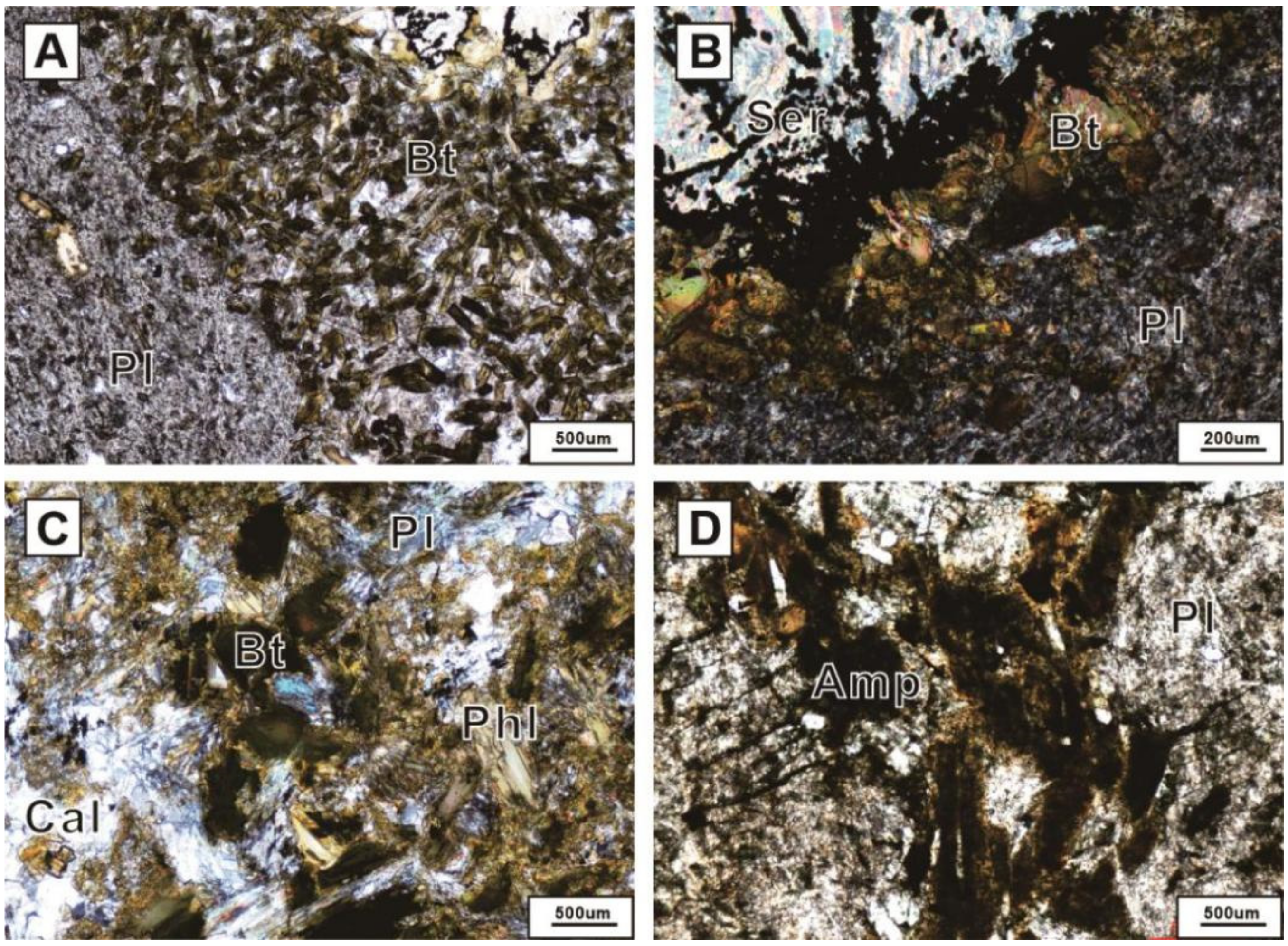
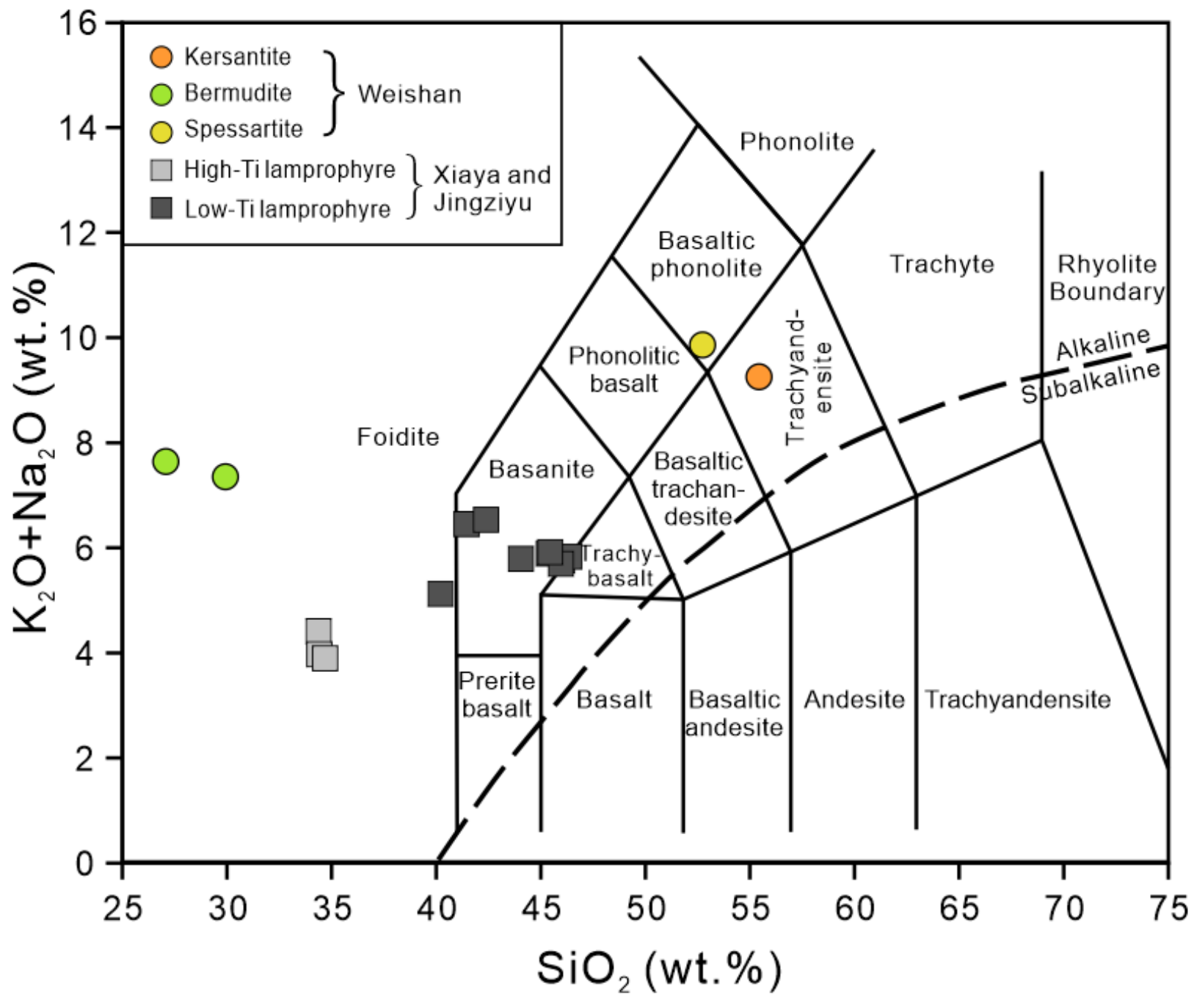

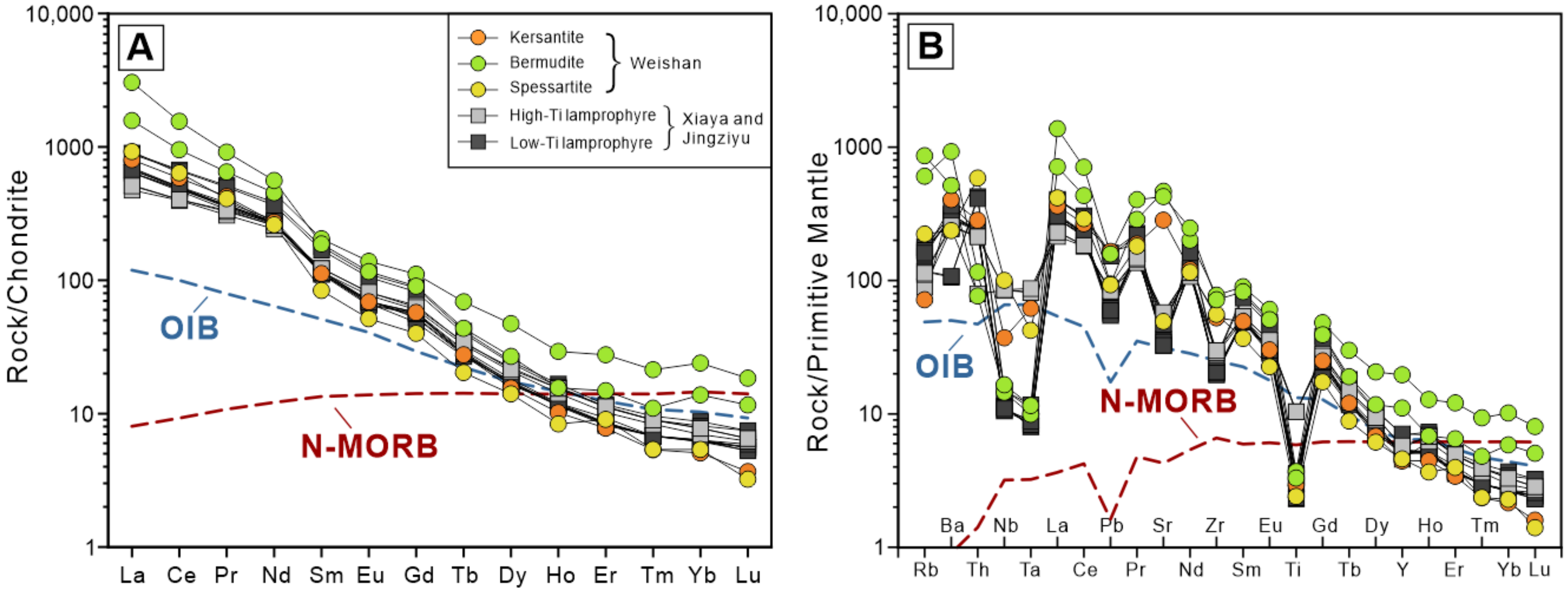

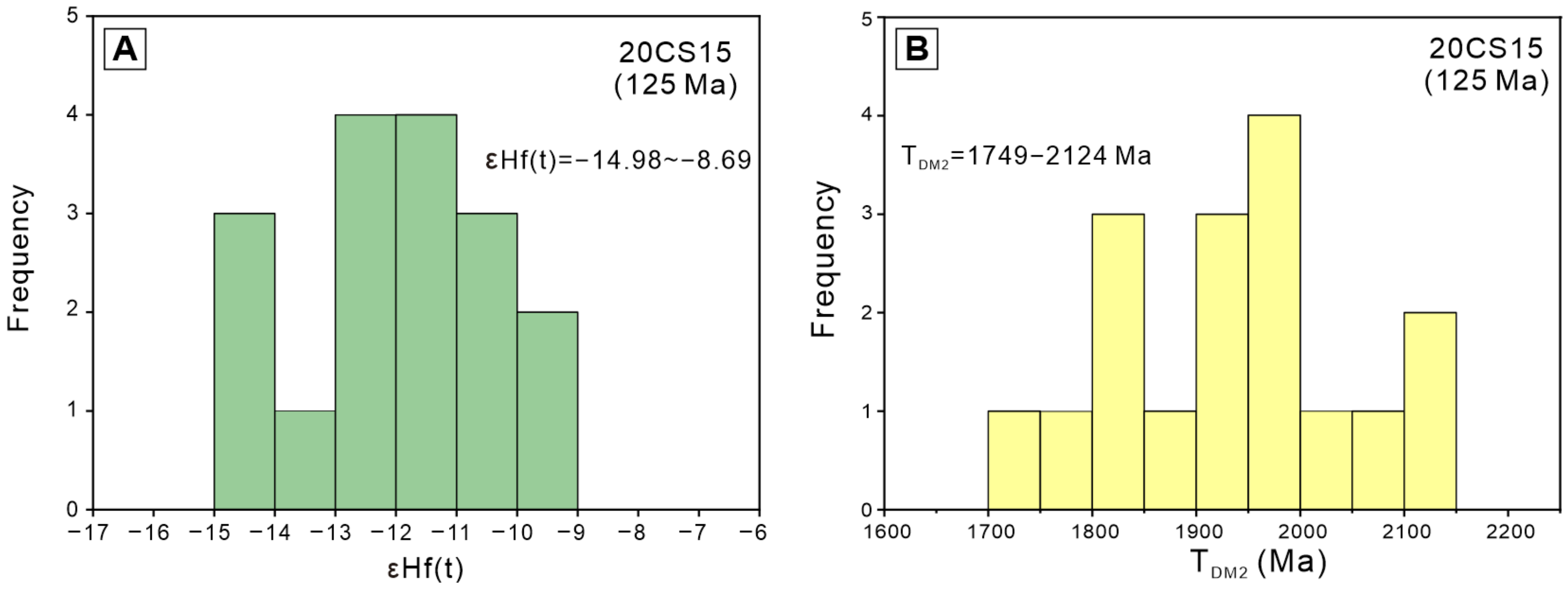
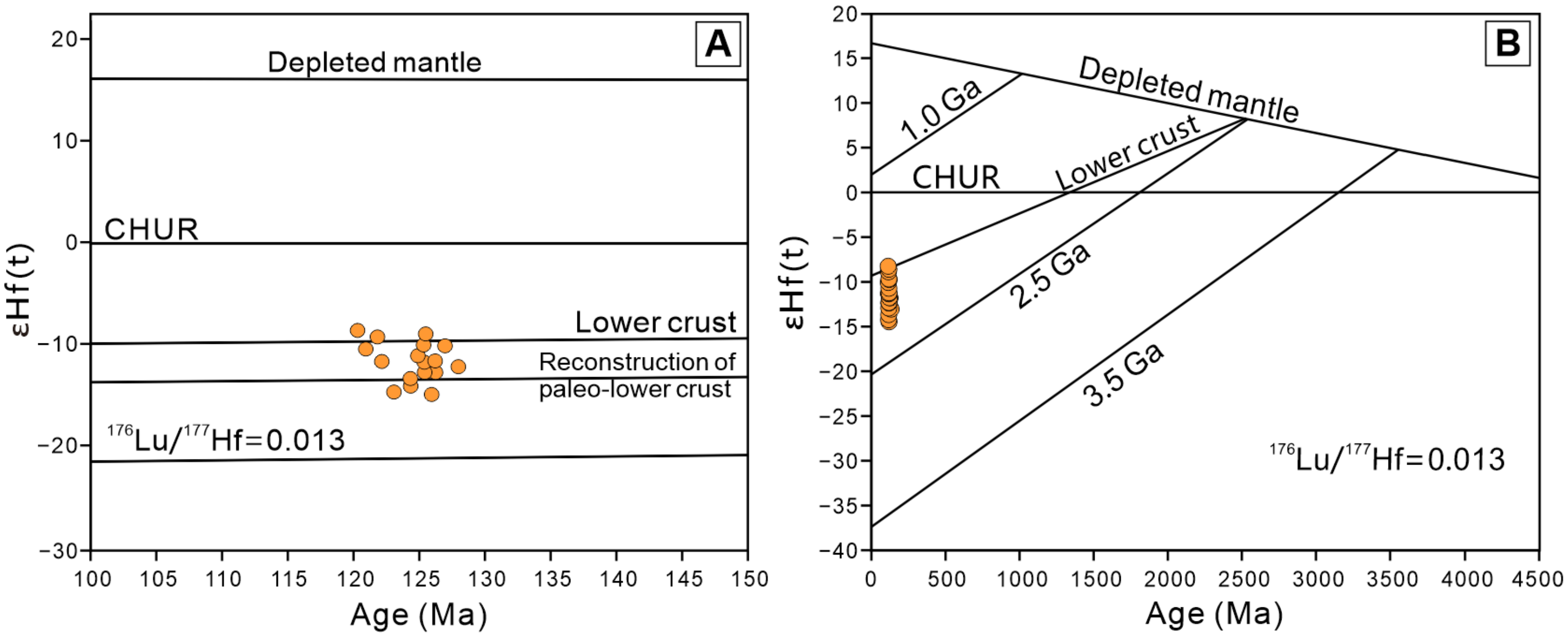

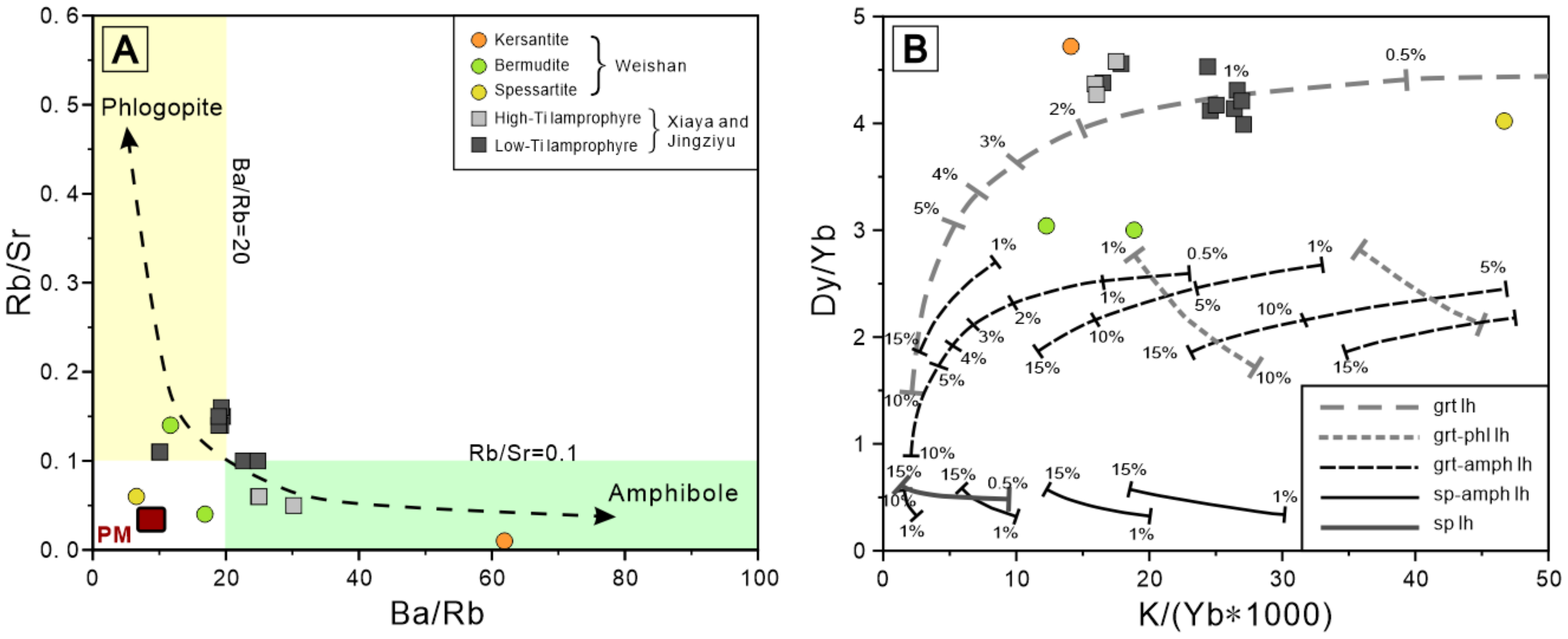
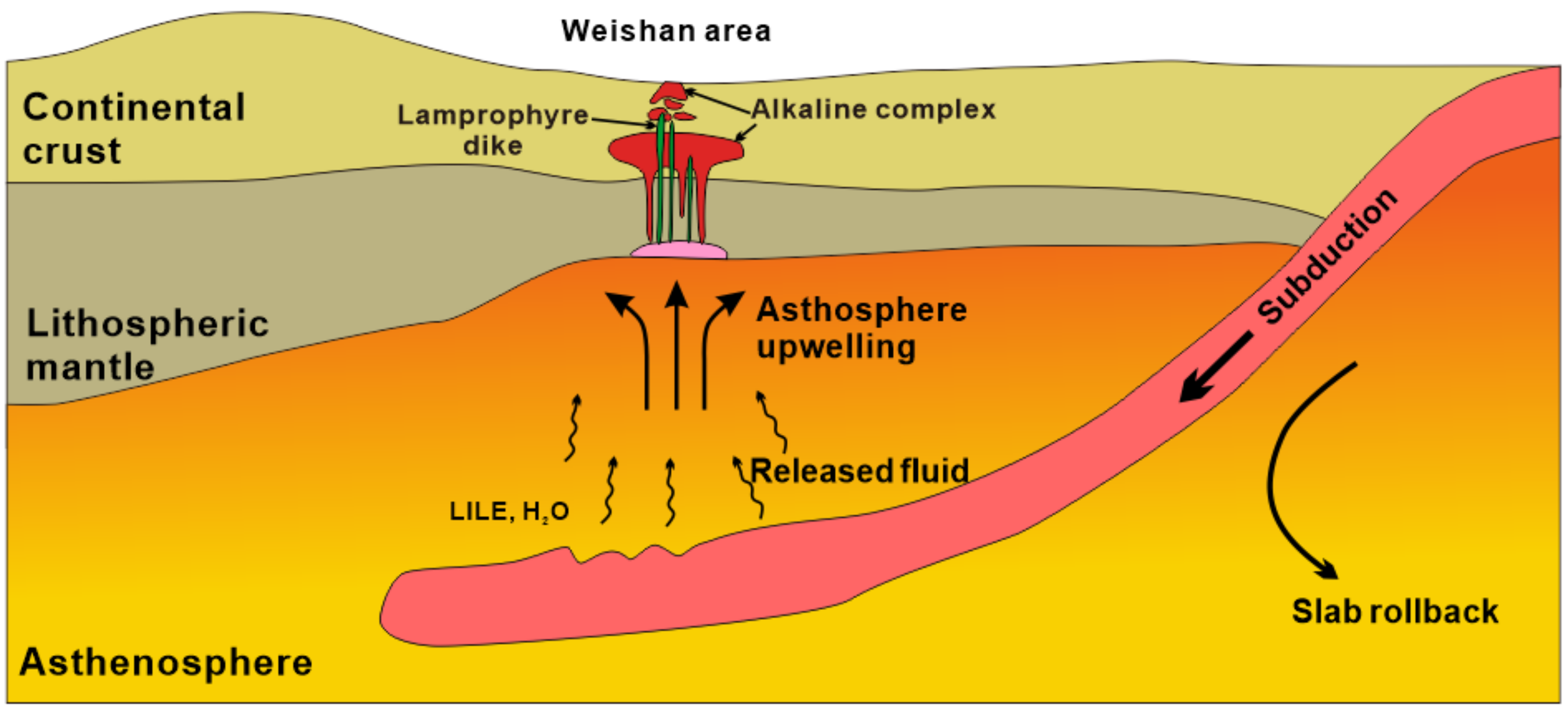
| Spot | Contents (ppm) | Th/U | Isotopic Ratios | Age (Ma) | ||||||||||||
|---|---|---|---|---|---|---|---|---|---|---|---|---|---|---|---|---|
| Pb | Th | U | 207Pb/206Pb | 2σ | 207Pb/235U | 2σ | 206Pb/238U | 2σ | 207Pb/206Pb | 2σ | 207Pb/235U | 2σ | 206Pb/238U | 2σ | ||
| 20CS15-01 | 47.63 | 938.03 | 1892.70 | 0.50 | 0.05206 | 0.00140 | 0.14416 | 0.00385 | 0.01992 | 0.00024 | 287.1 | 58.3 | 136.7 | 3.4 | 127.1 | 1.5 |
| 20CS15-02 | 36.40 | 562.41 | 1511.96 | 0.37 | 0.05259 | 0.00142 | 0.14286 | 0.00355 | 0.01963 | 0.00024 | 309.3 | 58.3 | 135.6 | 3.2 | 125.3 | 1.5 |
| 20CS15-03 | 54.33 | 1088.00 | 2162.34 | 0.50 | 0.05250 | 0.00127 | 0.14309 | 0.00316 | 0.01965 | 0.00021 | 305.6 | 55.6 | 135.8 | 2.8 | 125.4 | 1.3 |
| 20CS15-04 | 84.72 | 1999.20 | 3290.22 | 0.61 | 0.05169 | 0.00118 | 0.14165 | 0.00297 | 0.01973 | 0.00019 | 272.3 | 53.7 | 134.5 | 2.6 | 125.9 | 1.2 |
| 20CS15-05 | 44.25 | 853.09 | 1803.27 | 0.47 | 0.05221 | 0.00133 | 0.14189 | 0.00344 | 0.01953 | 0.00021 | 294.5 | 57.4 | 134.7 | 3.1 | 124.7 | 1.3 |
| 20CS15-06 | 44.30 | 974.70 | 1863.56 | 0.52 | 0.05075 | 0.00135 | 0.13469 | 0.00357 | 0.01908 | 0.00023 | 227.8 | 65.7 | 128.3 | 3.2 | 121.8 | 1.4 |
| 20CS15-07 | 37.20 | 673.85 | 1522.13 | 0.44 | 0.05266 | 0.00126 | 0.14469 | 0.00334 | 0.01977 | 0.00023 | 322.3 | 55.6 | 137.2 | 3.0 | 126.2 | 1.5 |
| 20CS15-08 | 41.76 | 850.65 | 1736.81 | 0.49 | 0.04988 | 0.00133 | 0.13640 | 0.00365 | 0.01966 | 0.00025 | 190.8 | 61.1 | 129.8 | 3.3 | 125.5 | 1.6 |
| 20CS15-09 | 45.63 | 763.78 | 1838.45 | 0.42 | 0.05226 | 0.00146 | 0.14132 | 0.00380 | 0.01948 | 0.00028 | 298.2 | 67.6 | 134.2 | 3.4 | 124.4 | 1.8 |
| 20CS15-10 | 43.32 | 710.59 | 1723.66 | 0.41 | 0.05079 | 0.00147 | 0.13872 | 0.00400 | 0.01964 | 0.00028 | 231.6 | 68.5 | 131.9 | 3.6 | 125.4 | 1.8 |
| 20CS15-11 | 42.12 | 750.29 | 1656.49 | 0.45 | 0.05309 | 0.00139 | 0.14495 | 0.00363 | 0.01966 | 0.00027 | 331.5 | 59.3 | 137.4 | 3.2 | 125.5 | 1.7 |
| 20CS15-12 | 55.06 | 972.20 | 2289.50 | 0.42 | 0.05292 | 0.00136 | 0.14069 | 0.00340 | 0.01920 | 0.00023 | 324.1 | 59.3 | 133.7 | 3.0 | 122.6 | 1.4 |
| 20CS15-13 | 45.31 | 853.08 | 1793.17 | 0.48 | 0.05321 | 0.00142 | 0.14380 | 0.00375 | 0.01953 | 0.00021 | 338.9 | 61.1 | 136.4 | 3.3 | 124.7 | 1.3 |
| 20CS15-14 | 35.08 | 544.69 | 1418.67 | 0.38 | 0.05240 | 0.00154 | 0.14184 | 0.00391 | 0.01966 | 0.00026 | 301.9 | 66.7 | 134.7 | 3.5 | 125.5 | 1.7 |
| 20CS15-15 | 40.32 | 578.15 | 1639.03 | 0.35 | 0.05073 | 0.00130 | 0.13719 | 0.00357 | 0.01956 | 0.00022 | 227.8 | 59.3 | 130.5 | 3.2 | 124.9 | 1.4 |
| 20CS15-16 | 36.25 | 605.66 | 1416.37 | 0.43 | 0.05085 | 0.00135 | 0.13878 | 0.00370 | 0.01978 | 0.00022 | 235.3 | 61.1 | 132.0 | 3.3 | 126.2 | 1.4 |
| 20CS15-17 | 36.46 | 617.81 | 1506.39 | 0.41 | 0.05189 | 0.00128 | 0.13761 | 0.00328 | 0.01928 | 0.00021 | 279.7 | 55.6 | 130.9 | 2.9 | 123.1 | 1.3 |
| Sample | Age (Ma) | 176Lu/177Hf | 176Hf/177Hf | 2σ | εHf(0) | εHf(t) | TDM1 | TDM2 | fLu/Hf |
|---|---|---|---|---|---|---|---|---|---|
| 20CS15-1 | 127.1 | 0.0013 | 0.282408 | 0.000037 | −12.87 | −10.20 | 1202 | 1824 | −0.96 |
| 20CS15-2 | 125.3 | 0.0012 | 0.282411 | 0.000031 | −12.77 | −10.12 | 1195 | 1818 | −0.96 |
| 20CS15-3 | 125.4 | 0.0012 | 0.282335 | 0.000033 | −15.45 | −12.80 | 1302 | 1987 | −0.96 |
| 20CS15-4 | 125.9 | 0.0015 | 0.282274 | 0.000035 | −17.61 | −14.98 | 1398 | 2124 | −0.95 |
| 20CS15-5 | 124.7 | 0.0011 | 0.282381 | 0.000029 | −13.83 | −11.18 | 1234 | 1884 | −0.97 |
| 20CS15-6 | 121.8 | 0.0014 | 0.282436 | 0.000032 | −11.88 | −9.32 | 1166 | 1765 | −0.96 |
| 20CS15-7 | 126.2 | 0.0012 | 0.282366 | 0.000032 | −14.36 | −11.69 | 1258 | 1918 | −0.96 |
| 20CS15-8 | 125.5 | 0.0017 | 0.282335 | 0.000032 | −15.45 | −12.84 | 1319 | 1989 | −0.95 |
| 20CS15-9 | 124.4 | 0.0012 | 0.282297 | 0.000030 | −16.80 | −14.17 | 1355 | 2072 | −0.96 |
| 20CS15-10 | 125.4 | 0.0011 | 0.282363 | 0.000032 | −14.46 | −11.81 | 1259 | 1924 | −0.97 |
| 20CS15-11 | 125.5 | 0.0014 | 0.282442 | 0.000030 | −11.67 | −9.03 | 1157 | 1750 | −0.96 |
| 20CS15-12 | 122.6 | 0.0013 | 0.282367 | 0.000029 | −14.32 | −11.75 | 1260 | 1918 | −0.96 |
| 20CS15-13 | 124.7 | 0.0011 | 0.282318 | 0.000030 | −16.06 | −13.42 | 1322 | 2025 | −0.97 |
| 20CS15-14 | 125.5 | 0.0011 | 0.282349 | 0.000030 | −14.96 | −12.30 | 1278 | 1955 | −0.97 |
| 20CS15-15 | 124.9 | 0.0014 | 0.282403 | 0.000029 | −13.05 | −10.43 | 1212 | 1837 | −0.96 |
| 20CS15-16 | 126.2 | 0.0012 | 0.282334 | 0.000026 | −15.49 | −12.82 | 1303 | 1989 | −0.96 |
| 20CS15-17 | 123.1 | 0.0014 | 0.282282 | 0.000031 | −17.33 | −14.75 | 1383 | 2107 | −0.96 |
Publisher’s Note: MDPI stays neutral with regard to jurisdictional claims in published maps and institutional affiliations. |
© 2022 by the authors. Licensee MDPI, Basel, Switzerland. This article is an open access article distributed under the terms and conditions of the Creative Commons Attribution (CC BY) license (https://creativecommons.org/licenses/by/4.0/).
Share and Cite
Sun, Y.-Z.; Qiu, K.-F.; An, M.-G.; Li, S.-S.; Shang, Z.; Wang, Y. Geochronological and Geochemical Constraints on the Petrogenesis of Lamprophyre from the Giant Weishan REE Deposit in China. Minerals 2022, 12, 706. https://doi.org/10.3390/min12060706
Sun Y-Z, Qiu K-F, An M-G, Li S-S, Shang Z, Wang Y. Geochronological and Geochemical Constraints on the Petrogenesis of Lamprophyre from the Giant Weishan REE Deposit in China. Minerals. 2022; 12(6):706. https://doi.org/10.3390/min12060706
Chicago/Turabian StyleSun, Yi-Zhan, Kun-Feng Qiu, Mao-Guo An, Shan-Shan Li, Zhen Shang, and Yu Wang. 2022. "Geochronological and Geochemical Constraints on the Petrogenesis of Lamprophyre from the Giant Weishan REE Deposit in China" Minerals 12, no. 6: 706. https://doi.org/10.3390/min12060706
APA StyleSun, Y.-Z., Qiu, K.-F., An, M.-G., Li, S.-S., Shang, Z., & Wang, Y. (2022). Geochronological and Geochemical Constraints on the Petrogenesis of Lamprophyre from the Giant Weishan REE Deposit in China. Minerals, 12(6), 706. https://doi.org/10.3390/min12060706








